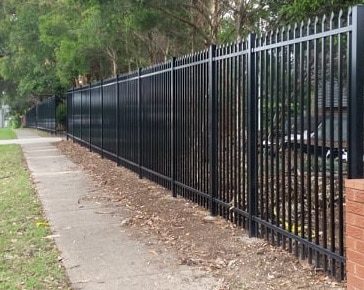Introduction
In https://parapetfencing.com.au/ a world progressively aware of ecological issues, the choice of materials in building tasks has actually gained unmatched value. This is particularly true in the world of fencing, where consumers are frequently confronted with many options that can considerably impact both aesthetics and the environment. In this short article, we explore The Environmental Impact of Choosing Sustainable Materials with Fence Experts, diving deep into how going with sustainable materials can contribute to a healthier planet while offering useful advantages for homeowners and organizations alike.

The Environmental Effect of Choosing Sustainable Products with Fence Experts
When it concerns fencing, the materials you pick can either add to ecological deterioration or promote sustainability. Sustainable products are those that are eco-friendly, sustainable, and have a minimal carbon footprint. The choices made by property owners and contractors alike can significantly affect communities, wildlife environments, and even local communities.
Why Select Sustainable Fencing Materials?
Opting for sustainable materials in your fencing project can yield several advantages:
- Reduced Carbon Footprint: Sustainable materials usually have a lower carbon footprint compared to traditional options. Longevity: Many sustainable products use toughness that can last longer than standard options. Aesthetics: Modern sustainable fencing options typically present visually pleasing designs. Cost-effectiveness: While initial costs might be higher, sustainable fences often conserve cash in the long run due to minimized upkeep needs.
Key Sustainable Fencing Options
Several eco-friendly products stand apart when it concerns fencing:

Each of these options has special characteristics that make them ideal for numerous applications.
Understanding Timber Paling as a Sustainable Option
What is Timber Paling?
Timber paling is an age-old method of structure fences using wooden planks or panels. However, not all wood is developed equivalent; sustainably sourced wood makes a significant difference.
Benefits of Lumber Paling
- Renewable Resource: When sourced from certified sustainable forests, timber serves as a sustainable resource. Carbon Sequestration: Trees soak up CO2 during their development; thus, using timber contributes favorably to reducing climatic carbon levels. Aesthetic Appeal: Timber paling offers a natural appearance that blends magnificently with outdoor landscapes.
FAQs About Lumber Paling
Is timber paling expensive?- While preliminary costs might be greater than some artificial options, its longevity frequently validates the investment over time.
- Regular sealing and treatment versus insects will guarantee its durability.
- Absolutely! Reclaimed wood includes character and further reduces ecological impact.
The Function of Fencing Contractors in Sustainable Choices
Fencing contractors play a vital role in executing sustainable practices in residential and commercial projects. By aligning themselves with environment-friendly providers and educating customers on sustainable alternatives like timber paling or Colorbond steel, they assist lead the way towards greener construction practices.
How Specialists Can Promote Sustainability
- Educating clients about environment-friendly alternatives Sourcing in your area produced materials Implementing waste-reduction methods during installation
Colorbond Steel: An Eco-Friendly Fencing Solution
What is Colorbond Steel?
Colorbond steel is a popular fencing material understood for its strength and versatility. Available in different colors and surfaces, it's not just durable however also developed with sustainability in mind.
Benefits of Colorbond Steel Fencing
- Low Upkeep: Unlike wooden fences needing periodic treatments, Colorbond steel needs very little upkeep. Recyclability: At the end of its life cycle, Colorbond can be fully recycled without losing quality. Weather Resistance: It endures severe Australian weather conditions much better than numerous other materials.
FAQs About Colorbond Fencing
Is Colorbond ideal for seaside areas?- Yes! Its corrosion-resistant properties make it perfect for coastal environments.
- High-quality Colorbond products come with warranties versus fading.
- Certainly! There are numerous color alternatives available to match your taste and landscaping needs.
The Growing Pattern of Recycled Plastic Fencing
Understanding Recycled Plastic Fencing
As customers end up being more ecologically mindful, recycled plastic fencing has emerged as an ingenious service within the industry.
Key Advantages of Recycled Plastic Fencing
- Durability: Resistant to rot, bugs, and UV rays. Minimal Ecological Effect: Made from post-consumer plastic waste lowers landfill contributions. Maintenance-Free: Needs no painting or staining.
FAQs About Recycled Plastic Fencing
How does recycled plastic compare cost-wise to conventional wood?- It may be slightly more costly upfront however conserves expenses on upkeep long-lasting.
- Yes! It's non-toxic and safe for animals to engage with.
- Generally not suggested; however, some specialized finishes might adhere well if needed.
Conclusion: Making Educated Choices
Choosing sustainable fencing materials is more than just an aesthetic choice; it's a financial investment in our world's future. Whether through timber paling or contemporary developments like Colorbond steel or recycled plastics, working with knowledgeable fencing contractors makes sure that homeowners can make informed decisions that line up with their values while still attaining functional and lovely results at their properties.
By comprehending the environmental impact connected with different fencing alternatives-- and actively looking for sustainable options-- we contribute favorably not simply to our immediate environment however likewise lead the way for future generations to take pleasure in nature's charm without compromise.
FAQs:

- Options consist of timber paling sourced from sustainable forests, Colorbond steel known for its recyclability, and fences made from recycled plastics or bamboo.
- Ask about their sourcing practices and whether they partner with providers who supply qualified sustainable products.
- Look for accreditations such as FSC (Forest Stewardship Council) which suggest responsible forest management.
- Initial expenses might differ based on product option; nevertheless, long-lasting cost savings on upkeep often offset initial investments.
- Yes! With appropriate planning and tools, DIY enthusiasts can successfully set up numerous types of sustainable fencing.
- Timber needs regular sealing; Colorbond requires very little care; recycled plastic requires no special treatment at all.
This thorough exploration targets at shedding light on how making informed options about fencing materials leads us towards sustainability while enhancing our living spaces aesthetically too!